Caster Usage Precaution
Usage
Casters are objects that are attached to transfer equipment and various types of other equipment to facilitate the movement and transfer of objects indoors and within premises. They are used intermittently under human power. When choosing a caster, make sure to select one that satisfies the task and usage conditions, attach it correctly, and only use it to specification.
Caster Selection & Usage Conditions
Please select an appropriate caster by considering the task, required functions and usage conditions. In particular, please pay attention to the following points.
(1) Reasonable Allowable Load
The allowable loads indicated in the catalog represent load limits that allow for ease of movement when transferring objects safely for an extended period of time under human power over level surfaces. Please estimate the total weight of objects to be loaded and select a caster with the corresponding allowable load. Furthermore, even when using four casters, there are times when the load may be borne by only three casters. Therefore, the total load limit is generally calculated as 80% of the original number, using an equation such as the one below.
* When using 4 casters
Total Load Limit = Allowable load (single caster) x 4 x 0.8.
When using casters of varied size at the same time, make sure to calculate the total load based on the allowable load of the caster with lower allowable load.
* According to the Measurement Law revision, weight (kg) must be clearly differentiated into mass (kg) and force (kgf).
The force expression is converted into N (newtons) or daN (decanewtons).
1 daN = 10 N ≒ 1.02 kgf (1 kgf ≒ 9.8 N = 0.98 daN) (Conversion coefficient: 9.8 → 9.80665)
(2) Travel Speed
Please use the casters intermittently at travel speeds less than walking speed, on level surfaces at ordinary room temperatures. (Please avoid continued use, as it generates heat. Excluding the 80-series towing caster.)
| Wheel Diameter | Usage Speed |
|---|---|
| 75 mm and under | 2 km/h or less |
| 100 mm and over | 4 km/h or less |
(3) Usage Conditions
Please determine wheel diameter, material, attachment method (plate, screw-in, etc.) and model (swivel, rigid, with stopper) according to the equipment to be attached to, through inspection of the actual product or catalog.
(4) Stopper
Wear and damage due to use over a prolonged period can cause deterioration in functionality that may go unnoticed, so please exercise caution.
In general, the braking force of harder wheels (nylon, phenol, etc.) is inferior to that of softer wheels from the initial time of shipment.
If there is a special requirement for braking performance as part of product safety, please use another means for braking (wheel stoppers, Nansin Locks, etc.)
(5) Usage Environment
In general, it is assumed that casters will be used at ordinary room temperature, within premises.
Please avoid using casters in unusual environments featuring high temperatures, low temperatures, high humidity, acidity, alkalinity, saltiness, solvents, oils, seawater, or chemicals. Product deterioration may be accelerated.
When use in such environments is unavoidable, metal fittings, wheels, and greases appropriate for the individual task are required. Furthermore, the material may contaminate the surface.
Caster Installation
Please take note of the following points when installing casters.
(1) Please use casters from the same series.
(2) Please attach casters so that the mounting surface is level.
(3) Please attach swivel casters so that the swivel axis is vertical.
(4) Please attach rigid casters so that they run parallel.
(5) After determining the attachment area, attach the caster correctly using bolts, nuts and washers matching the mounting hole dimensions to ensure that it will not become loose.
In particular, when attaching screw-in casters, fasten the hexagonal part of the screw with suitable torque. If fastened too much, the axis will become stressed and may break. (For screws with diameter of 12 mm, the optimum torque is 20 – 50 N∙m (200 – 500 kgf∙cm))
(6) For screw-in casters, please avoid tightening the actual caster when the swivel stopper is in the ON position. It may cause deformation or breakage of the stopper.
Usage Precautions
(1) Configuration Conditions
Do not apply loads that are heavier than the reasonable allowable load.
Avoid applying uneven loads.
For rigid casters, do not apply excessive force in directions that differ from the wheel rotation direction.
Avoid use that causes shocks (dropping, vibration, knocks from forklift forks).
Avoid use on very rough surfaces, and surfaces with sharp protrusions.
Do not install on trailers. (Excluding the towing caster)
Only use caster-attached equipment for its originally intended purpose.
(2) Stopper
Make sure to only operate stopper pedals while wearing shoes.
Do not forcibly move the equipment while stoppers are engaged.
Do not stamp on stopper pedals with excessive force, or strike them with a hammer.
Avoid leaving the equipment on a sloped surface with the stoppers engaged. In unavoidable circumstances, use wheel stoppers or another measure.
Do not operate stopper pedals while the equipment is in motion.
(3) Product Modification
Be aware that we will not assume responsibility for products that have been modified, coated, or welded onto equipment.
Inspections, Maintenance & Replacement
(1) In order to prevent accidents and ensure the long-term use of products, carry out periodic inspections and maintenance.
(2) General inspection should include: checking if the caster mounting section is fastened tightly; checking for damage, cracks or deformation of the caster; checking the wheel bearings and shaft fastening; checking for tire damage, cracks or wear. If any looseness is discovered within the mounting sections or shaft fastening section, perform retorquing. Should you discover any other abnormalities, cease use immediately.
(3) If the products develop any defects such as deterioration or damage, please replace them immediately. (Replace products as a whole, not just individual components.)
(4) If a foreign body becomes entangled around the swivel or wheel section, remove it immediately as it will cause swivel/rotation issues.
* If you are unsure about something, please contact us before use.
Please take note of the following points in relation to use.
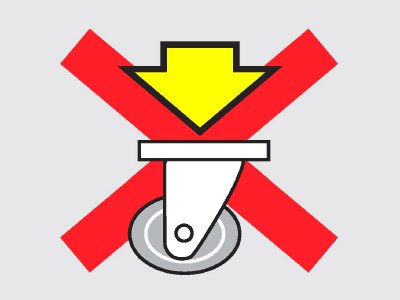 Please do not apply loads that are heavier than the reasonable allowable load. Please do not apply loads that are heavier than the reasonable allowable load. |
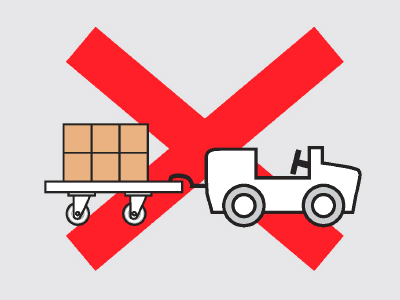 Do not install on trailers. (Excluding the towing caster) Do not install on trailers. (Excluding the towing caster) |
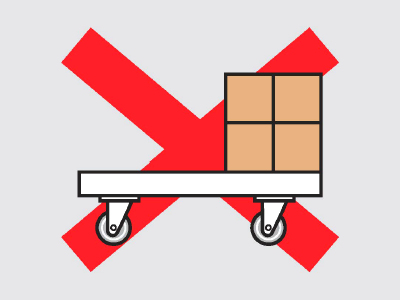 Avoid applying uneven loads. Avoid applying uneven loads. |
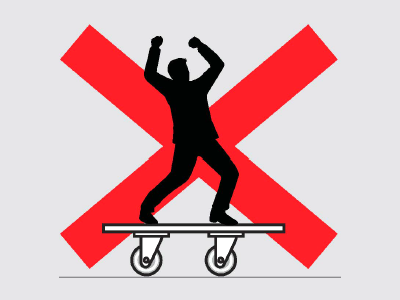 Only use caster-attached equipment for its originally intended purpose. Only use caster-attached equipment for its originally intended purpose. |
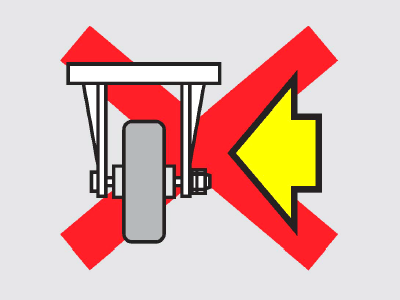 For rigid casters, do not apply excessive force in directions that differ from the wheel rotation direction. For rigid casters, do not apply excessive force in directions that differ from the wheel rotation direction. |
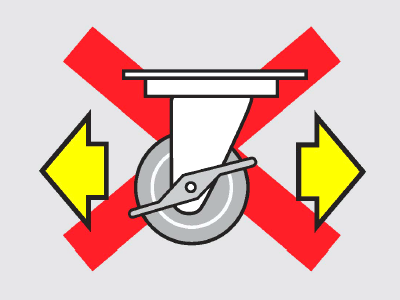 Do not forcibly move the equipment while stoppers are engaged. Do not forcibly move the equipment while stoppers are engaged. |
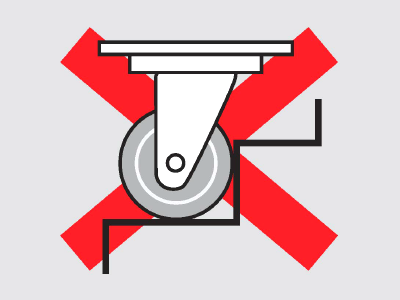 Avoid use that causes shocks (dropping, vibration, knocks from forklift forks). Avoid use that causes shocks (dropping, vibration, knocks from forklift forks). |
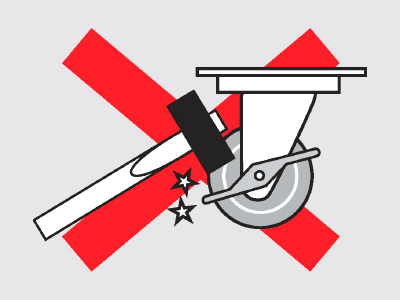 Do not stamp on stopper pedals with excessive force, or strike them with a hammer. Do not stamp on stopper pedals with excessive force, or strike them with a hammer. |
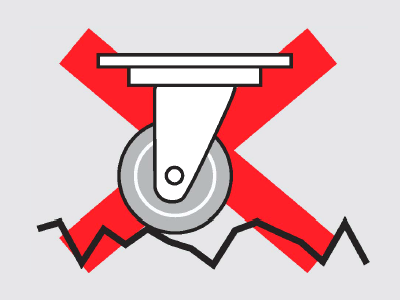 Avoid use on very rough surfaces, and surfaces with sharp protrusions. Avoid use on very rough surfaces, and surfaces with sharp protrusions. |
 Avoid leaving the equipment on a sloped surface with the stoppers engaged. Avoid leaving the equipment on a sloped surface with the stoppers engaged. |
 Please avoid using casters in extreme environments. Please avoid using casters in extreme environments. |
|

